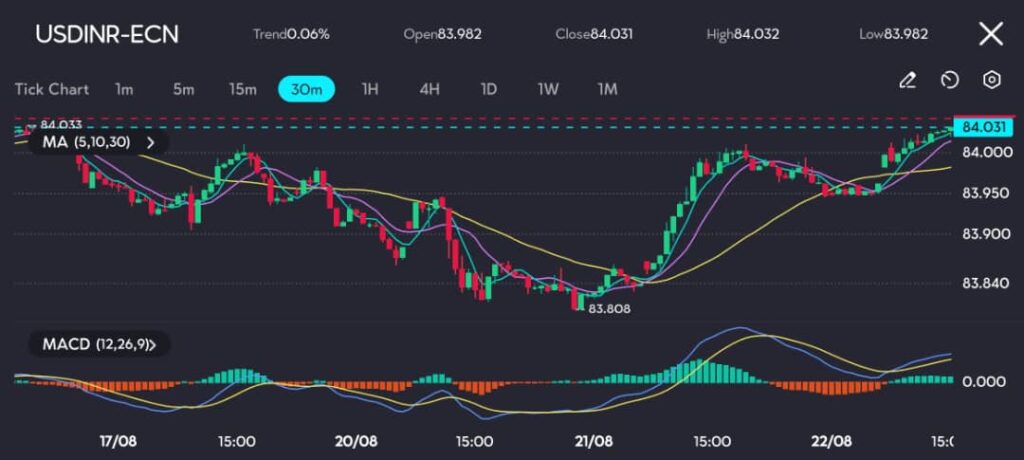Key points:
- Indian rupee set to open near 83.9225 after Fed minutes, with bias leaning towards a downside.
- Fed rate cut expectations firm up, but Asian currencies remain weak, pausing after recent rallies.
The Indian rupee is likely to start Thursday’s session with little change, despite the U.S. Federal Reserve’s dovish minutes failing to provide a lift to Asian currencies. The 1-month non-deliverable forward (NDF) suggests the rupee (USDINR) will open close to 83.9225, nearly unchanged from the previous session.

See: Indian rupee sees a decline, trading at 84.031 on the VT Markets app.
The USD/INR pair has shown significant volatility this week, with the rupee recently experiencing a brief recovery, climbing to 83.7550 on Tuesday. However, this respite was short-lived as the currency quickly reversed course, nearing its lifetime low of 83.9725.
This downward pressure on the rupee has been driven by factors such as importer hedging and weak portfolio inflows, which have exacerbated the currency’s decline.
Today’s chart shows the USD/INR pair currently trading at 84.031, with the price testing resistance near the 84.032 level. The Moving Averages (5, 10, 30) are sloping upward, indicating strong bullish momentum.
The MACD indicator also reflects this positive sentiment, with the MACD line well above the signal line and the histogram in positive territory, suggesting further upside potential.
On Wednesday, the rupee declined by 0.16%, marking its worst performance in nearly two months, underscoring the challenges it faces. Traders should monitor the 84.032 resistance level closely, as a break above this could signal further depreciation of the rupee. Conversely, if the pair pulls back, support around 83.808 may offer some relief.
Market participants will need to keep an eye on global risk sentiment, portfolio flows, and any potential intervention by the Reserve Bank of India, which could impact the pair’s direction in the coming days.
Fed minutes support September rate cut, boosting market expectations
The Fed’s July 30-31 meeting minutes revealed that a “vast majority” of officials were inclined towards a rate cut in September. Some policymakers even expressed willingness to reduce borrowing costs in July, reflecting a strong dovish stance. This has solidified market expectations of a rate cut next month, which had already been fully priced in.
The Fed minutes “echo a dovish tone,” aligning with the downward revisions to U.S. payroll figures, which have further fueled rate cut bets. Despite these expectations, Asian currencies, including the rupee, were weaker on Thursday, taking a breather after recent rallies.
You might be interested: Rupee stabilises on U.S. dollar weakness and hedging by importers
Rupee dips as dollar demand persists; may test new lows if conditions worsen
The rupee’s recent dip underscores the persistent demand for the dollar, driven by factors such as importer hedging and subdued portfolio inflows. With the RBI’s interventions, the currency is likely to stay near the 84 mark in the near term. However, if global risk sentiment worsens or dollar demand increases, the rupee may test new lows.
Given the Fed’s dovish stance, the dollar could face downward pressure, which might eventually provide some relief to the rupee. Nonetheless, the local currency remains vulnerable to external factors, especially if there is a further decline in global risk appetite or an escalation in geopolitical tensions.
In related indicators, the dollar index (DXY) was up at 101.24, Brent crude futures dipped 0.2% to $75.9 per barrel, and the yield on the 10-year U.S. note stood at 3.81%. According to NSDL data, foreign investors bought a net $481.6 million worth of Indian shares and $107.7 million worth of Indian bonds on August 21, indicating sustained, albeit cautious, interest in Indian assets.
Start trading now — click here to create your live VT Markets account.









